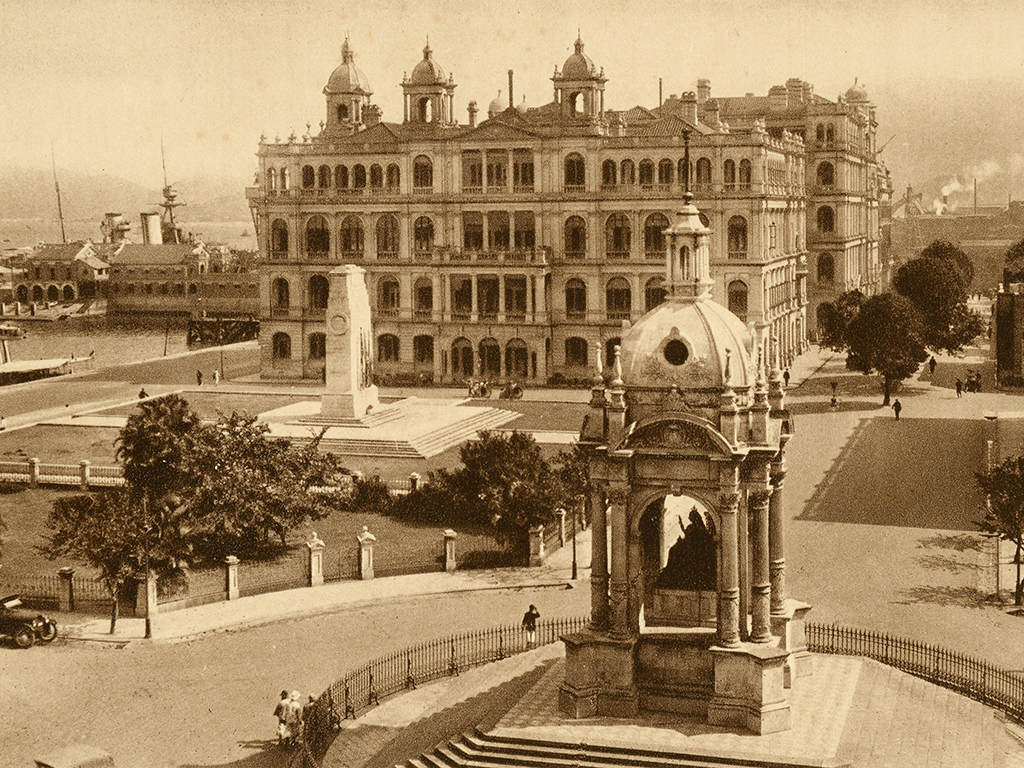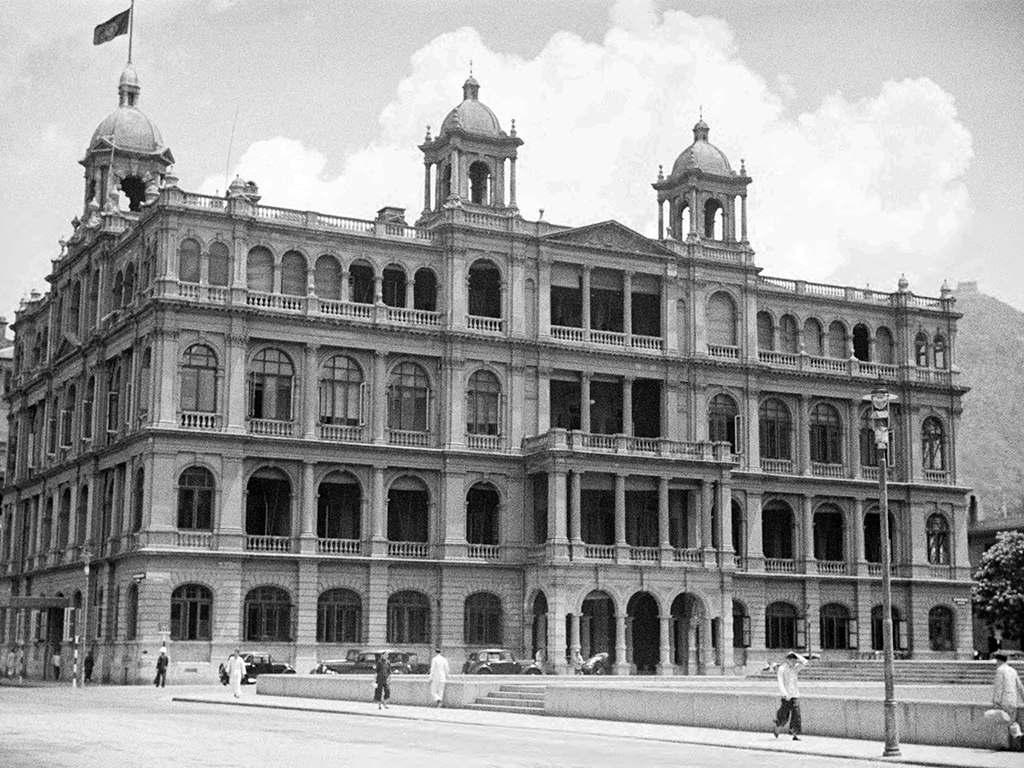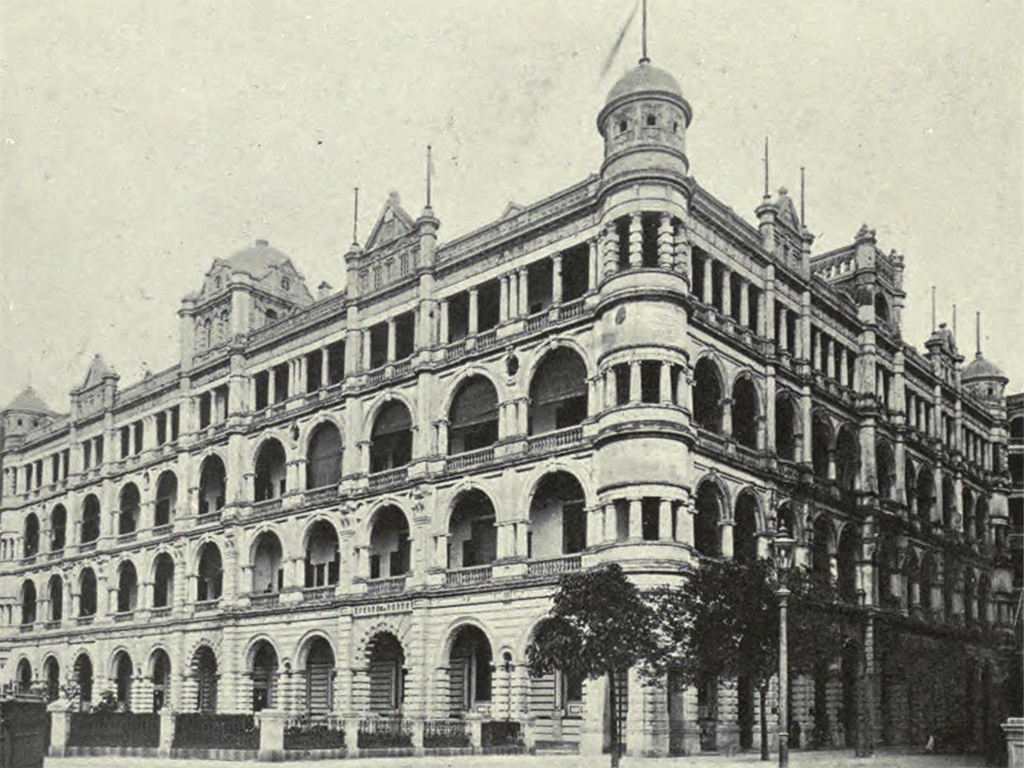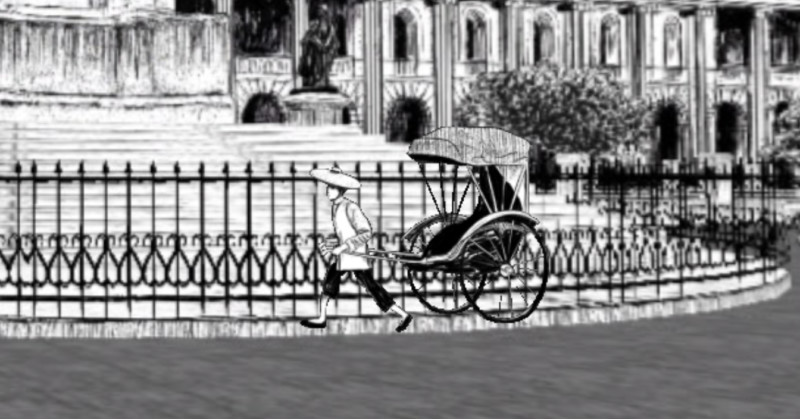Central – Chater Road ca.1925

360-degree panoramic artwork created by Pen So
Historical Hotspots:
The Second HSBC Main Building
This is the head office of one of Hong Kong’s largest banks: HSBC. The second of four generations of the HSBC Main Building was constructed by the architectural firm Wilson & Bird, with the 23-year-old Clement Palmer supervising as the architect. His vision blended different architectural styles, creating a very unique design. To make way for the new premises, the bank’s first head office Wardley House was demolished. The new building opened for business in 1886 and was replaced in 1935.
Sir Thomas Jackson, at 35 years old, became the bank’s youngest ever Chief Manager in 1877. Already a renowned exchange banker, Jackson took the helm and presided over a period of extraordinary growth. Such was his leadership that Jackson returned from retirement twice to guide HSBC through economic crises in 1890 and 1893 and returned the bank to stability. In 1906, HSBC commissioned a bronze likeness of Jackson to stand in Statue Square, commemorating a legendary banking life. Sir Henry Arthur Blake, the Governor of Hong Kong, commented on Jackson’s impressive reputation that if anyone sent a letter addressed solely to “TJ China” from anywhere in the world, it would arrive at the bank at 1 Queen’s Road in Hong Kong. To test the theory, someone once sent a postcard entitled “TJ China” from the UK, which was in fact delivered to the correct address.
Photo courtesy of the Billie Love Historical Collection and Historical Photographs of China, University of Bristol
Statue Square

At the end of the 19th century, a reclamation project was carried out in the Central District. A consensus was reached between the government and HSBC to reserve the land in front of the bank to build the Royal Square. Royal Square was the first public venue in Hong Kong and the original name of the Statue Square. In 1896, a bronze statue of Queen Victoria was erected in the square to celebrate the Golden Jubilee of the Queen. Other bronze statues were then also erected in the square. At its maximum, there were nine statues. These bronze statues were lost during World War II. In the end, only the bronze statue of HSBC Chief Manager Sir Thomas Jackson could be relocated back to the square. The plaza was redesigned with landscaping work during the 100th anniversary of HSBC in 1966, and has, since then, evolved into its current appearance.
Why is the bronze statue of Queen Victoria called the “Queen’s Statue” in Chinese? This was due to a government officer’s misinterpretation of the English word “Queen”. During the Japanese occupation, the bronze statue of the Queen was confiscated by the Japanese army and converted into military supplies. After wartime, the Hong Kong government restored the bronze statue of Sir Thomas Jackson, the pair of bronze lions of HSBC and the statue of Queen Victoria with a broken hand. The damaged bronze statue of the Queen and pavilion of the bronze statue were displayed at Victoria Park in Causeway Bay after repair and the park inherited the name.
Image library reference: CO 1069/457 (36)
Photo courtesy of the National Archives of the United Kingdom
The Hong Kong Club

The Hong Kong Club made successful bids on the land in 1895, and the clubhouse was launched two years later. The Hong Kong Club was an association for foreigners (especially the British members) to gather for social and entertainment purposes in Hong Kong, as well as providing high-end catering and business services to senior government officials, senior local businessmen and celebrities. The Victorian-style clubhouse was 4-storey high, with a stone arched hall at the front entrance, a terrace on top and towers on both sides. In 1899, the rear building of the clubhouse was also completed, and it was connected to the front of the building by a flyover on the second floor.
The Hong Kong Club was established in 1846 by eight British businessmen residing in Hong Kong. Although it is called “The Hong Kong Club”, it was not open to everyone because membership qualifications were limited to European citizens only. Until the mid-1960s, the association began accepting Chinese members and opened its door to women since 1996. The clubhouse was once a prominent communication centre in terms of politics and commerce. To preserve the building, members objected the reconstruction plan of the building three times, the general public also initiated campaigns to protect it. In 1981, the clubhouse was eventually rebuilt due to the Mass Transit Railway construction project and its dilapidation issue.
Photo courtesy of the American Geographical Society Library, University of Wisconsin- Milwaukee Libraries
Queen’s Building

In 1899, the Queen’s Building was completed. It was an Italian Renaissance-style commercial building with a total of 4 floors and 16 offices. The building was developed by Chater & Mody and later had the ownership transferred to the Hongkong Central Estate Limited. The building was managed by Hongkong Land starting in 1899. In 1923, the Hongkong Central Estate Limited and Hongkong Land were amalgamated through an exchange of shares, and Queen’s Building was merged in as assets of Hongkong Land. In 1960, the building was reconstructed into The Mandarin. The hotel opened in 1963, and it has become a multinational hotel group now.
The “Queen” in the name of the Queen’s Building refers to Queen Victoria. The Queen’s Building garnered great attention following its completion due to the unlikely grandiose appearance, despite its status as a commercial building. The Director of Public Works even mentioned in the 1899 annual report, “…the principal building completed in the city that year was the very handsome building now known as Queen’s Building”. This was once the consulates of Russia, Denmark and Norway. Hongkong Land had initially planned to exchange the Queen’s Building for three other properties owned by Jardines at the junction of Pedder Street and Des Voeux Road. After the proposal was rejected, the building was converted into a hotel.
Photo courtesy of Moonchu Foundation and the Hong Kong Museum of History
Prince’s Building

Prince’s Building was completed in 1904 by Chater & Mody and entrusted to Hongkong Land for management. Its title was transferred a couple of times and then became the property of the Hongkong Central Estate Limited in 1914. It was later acquired by the bankers Joseph Brothers, then was acquired by Hongkong Land in 1927 and was demolished and reconstructed in 1962. In 1965, the 26-storey Prince’s Building was completed as an integrated complex for offices and shopping malls.
Mr. Chater named the Prince’s Building in memory of Queen Victoria’s eldest son, the Prince of Wales, who is King Edward VII. It was a well-known commercial building that attracted many international companies to settle their offices, including Japan’s Mitsui Bussan Kaisha, as well as companies from France, Portugal, Baghdad, the United States and the United Kingdom, and even law firms like Wilkinson & Grist, Deacons and Johnson Stokes & Master.
Photo courtesy of Special Collections, The University of Hong Kong Libraries.
Animation:

In 1880, the first rickshaw was introduced to Hong Kong from Japan. Due to the increasing number of rickshaws, the operators were mandated to register with the Government in 1916. In the 1920s, there was often a scenery of streets that were filled with rickshaws awaiting to carry their passengers from destination to destination.
